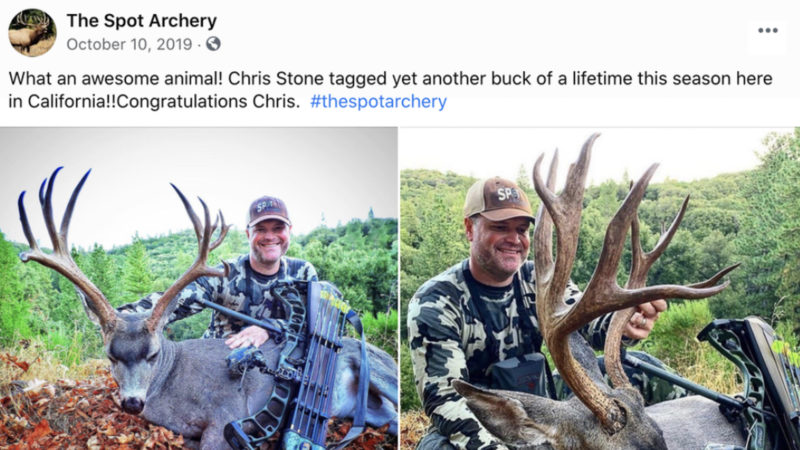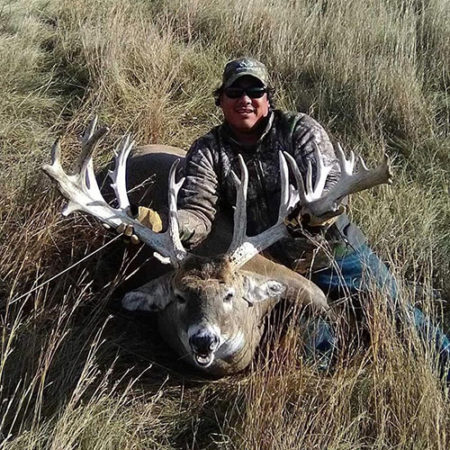It’s no secret that poachers make some pretty bad life decisions. They kill animals illegally, after all. However, if poaching an animal isn’t bad enough, these lowlifes sometimes want credit for their kill, and social media provides the perfect platform for them to brag of their prowess while still feeling somewhat anonymous.
Well, there’s that old saying about pride before a fall. And while it’s true that social media can help people stay connected, it helps law enforcement stay connected, too. Monitoring social media platforms has become a primary tactic for conservation officers trying to catch poachers and protect wildlife. In fact, here are 8 poachers who were busted thanks to posts on social media.
California

Joe Frater and Chris Stone had garnered quite a reputation for killing mature bucks in the Sierra foothills of Northern California with bow and arrow. Historically, the area rarely produced trophy-quality deer, but Frater and Stone had somehow unraveled its secrets and become social media rockstars in the process.
Unfortunately for them, one of the people following their success was Game Warden, David Moskat, who noticed that several deer weren’t tagged in the photos posted on Facebook or in videos on YouTube. Moskat then cross-referenced these kills with harvest reports and discovered that at least three had never been reported.
Over the next five months, wardens conducted an investigation that determined that Frater and Stone had not only failed to report harvests as required by law, but also intentionally misrepresented the locations of those kills and trespassed.
The main revelation, though, was that the duo had used bait to harvest these deer, and in California, baiting is strictly prohibited. Both men pleaded no contest to the charges.
Washington

Upon harvesting a mountain lion with his bow, Washington State hunter, Cody Young, went through all of the proper procedures to report the kill. The cougar was taken on September 9th in the Tatoosh Wilderness in Lewis County.
However, upon investigation, wildlife officers determined that Young hadn’t actually purchased his hunting license until September 10th. This case might have slipped through the cracks had a conservation officer not recalled that Young had been convicted of a hunting violation four years prior.
This prompted the officer to scour Young’s Facebook page where they found a description of the hunt with a picture of the dead lion posted at 8:05pm on September 10th.
The photo had been taken in complete darkness even though it was still daylight at the time the post was made. Officers then accessed surveillance video from where Young had purchased his license and made the discovery.
To further seal the deal, officers obtained Young’s cellphone records and found a photo taken of the dead lion on September 9th. And if that weren’t enough, Young allegedly sent a text message to a friend in which he bragged that he had “smoked a cougar” – a text that was sent before Young had even purchased the hunting license.
Florida

Somewhere near the top of the list for world’s dumbest poachers, you’ll no doubt find Aaron Griffis and Taylor Wise, who broke into a Florida deer farm on two separate occasions. Each time, they videoed themselves breaking in and killing multiple deer at night – and then posted those videos privately on Snapchat and Facebook.
It didn’t take long for the duo to get caught and charged with trespassing, taking deer at night, and felony charges for grand theft livestock since the deer were considered farm animals.
Pretty smooth operators, don’t you think?
Oregon
Oregon hunter, David Maxfield Jr., shot a bull elk in August of 2016. Like a lot of hunters, Maxfield was quick to share the photo of his kill to an Oregon hunting page on Facebook. Unfortunately for Maxfield, a law enforcement officer was keeping an eye on the Facebook page.
When an officer saw Maxfield’s post, his information was run through the state’s database. Results found that Maxfield never purchased an elk tag.
When confronted with the evidence, Maxfield confessed the crime, along with friend, Allen Boal, who was also charged with the crime.
Maxfield ended up getting $7,600 in fines and community service for the crime. Both men lost their hunting privileges for the next three years.

Maryland
In 2015, Tyler James Murphy, of Union Bridge, was convicted on eight counts of deer and turkey poaching. Two years later, Murphy posted photos on Facebook of an antlerless deer he’d killed in October but had failed to check in. A review of state records showed that Murphy had checked in two antlerless deer on December 3rd, purchased a Bonus Antlered Deer Stamp that evening, and then checked in a big 10-point the following day. This raised a few red flags with conservation officers.

To his credit, Murphy came clean upon questioning and volunteered that he had not killed two antlerless deer on December 3rd and had killed the 10-point prior to purchasing the bonus stamp. And if you want to know how fast charges can pile up in a case, consider the list of charges filed against Murphy over the ordeal: one charge of failing to report a kill within 24 hours, failing to report of Big Game Harvest Record before moving the deer, failing to obtain a Bonus Antlered Stamp before harvesting a second buck, failing to harvest two antlerless deer before hunting an additional antlered deer, and three counts of knowingly making false statements and information.
Maryland
Another Maryland case involved 19-year-olds Garrett Montgomery Smith and John Edward Jackson. A Snapchat story led officers to where Smith and Jackson had gotten their truck stuck in a muddy field.
During that same time, officers received complaints of somebody hunting deer at night in eastern Frederick County.
Fortunately for Smith and Jackson, help arrived to pull from the mud their Dodge Ram pickup truck with a lightbar attached to the front bumper. But, unfortunately for them, their rescuers were the same officers who now had witnesses who could identify their vehicle as being the one driven by the suspected poachers.
It was soon discovered that Smith and Jackson had shot a 5-point buck and four antlerless deer with rifles before becoming stuck in the field.
Montana
Not all poachers begin with the intent of an illegal harvest. Sometimes they are faced with a situation where they have to choose between what is ethically and morally responsible and what is simply about thrill killing and getting noticed on social media.
For instance, Austin Peterson, Trey Junhke, and Corbin Simmons were hunting one day when their dogs tracked a cougar across the border and into Yellowstone National Park. The three young men claimed that their GPS had malfunctioned and that they didn’t realize they had crossed park lines.
The problem is that, when questioned about the incident three months later, none of the men could keep their stories straight, mixing up details such as when and where they saw boundary posts, the color of the GPS screen when it malfunctioned, and where exactly they had left the lion carcass.
Of course, the only reason the incident was even investigated was because the group of hunters shared celebratory photos of themselves with the mountain lion via Instagram, Snapchat, and Facebook. One of the photos was taken looking down into the Black Canyon of Yellowstone, an area recognized by a fellow lion hunter. Others soon took notice of the familiar backgrounds in their social media posts, and although the posts were soon deleted, it was too late, and the three men were paid visits by law enforcement.

South Dakota
Another fence-climbing poacher was caught in South Dakota when he made the decision to hop a fence to snatch a trophy. The man shot into a high fence hunting preserve and killed a monster buck. He proceeded to climb the fence and took a picture with the buck. He then removed the head and threw it over the fence and left the meat to rot.
As it tends to do, the picture made its way onto social media. The nature of the buck’s rack obviously caught lots of attention. Particularly from the skeptics. A game farm was contacted and the owner of the game farm confirmed that it was his deer in the picture.

The bottom line – think before you act. Some hunters turn into poachers by a quick failure in the decision-making process. And, of course, there are others that seem to hunger for the opportunity to break the law. They are poachers through and through.
You won’t have to look far to find these guys. In fact, a quick scroll through social media may be all it takes.

 By
By 



